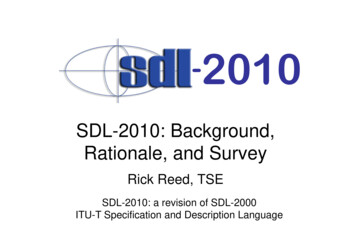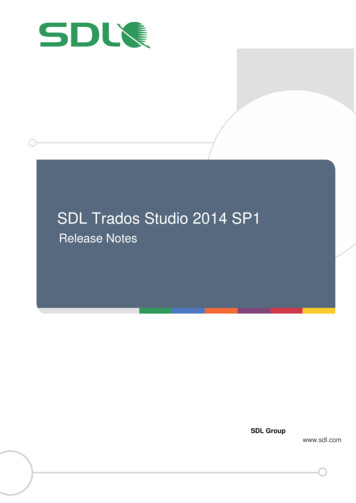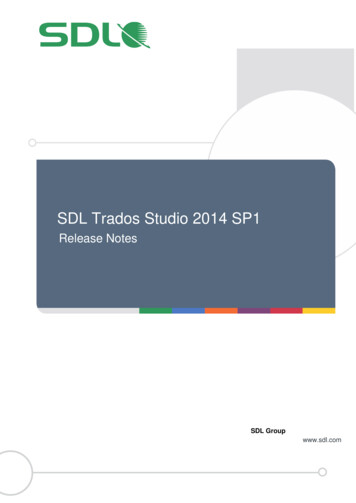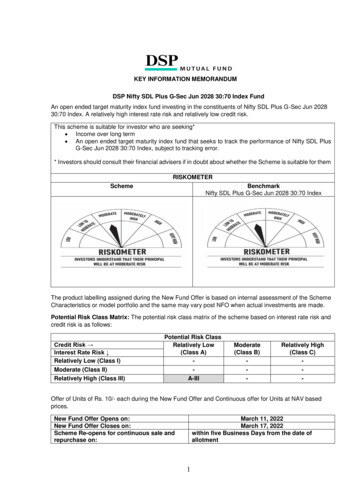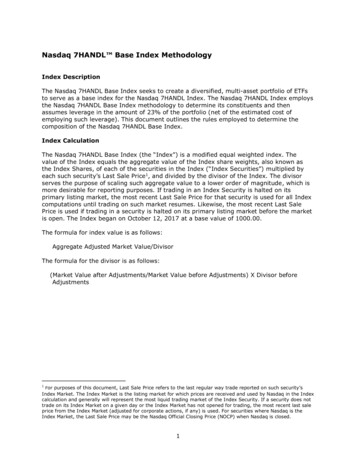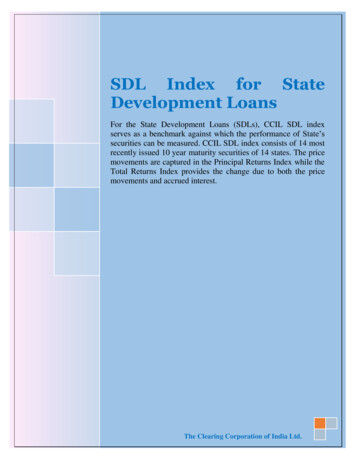
Transcription
SDL Index for StateDevelopment LoansFor the State Development Loans (SDLs), CCIL SDL indexserves as a benchmark against which the performance of State’ssecurities can be measured. CCIL SDL index consists of 14 mostrecently issued 10 year maturity securities of 14 states. The pricemovements are captured in the Principal Returns Index while theTotal Returns Index provides the change due to both the pricemovements and accrued interest.The Clearing Corporation of India Ltd.
TABLE OF CONTENTS1.INTRODUCTION . 22.RATIONALE. 33.DATA DETAILS . 34.INDEX LOGIC . 45.INDEX REBALANCING . 56.TREATMENT OF HOLIDAYS / NON-WORKING DAYS . 67.INDEX RELEASES . 61
1. INTRODUCTIONThe State government securities market is the prime funding avenue for the stategovernments. Principal characteristics of State Developments Loans (SDLs) are large numberof small issues, illiquid and scattered trades, and lower outstanding volume as compared tocentral government securities. Frequent new issuances have resulted into a large number ofsecurities with scanty trading in the market. As a result, selection and maintenance of SDLportfolio for the construction of a representative index is challenging.SDLs are issued in the primary market through normal auctions conducted by the ReserveBank of India (RBI). There exists a secondary market for SDLs and they are traded andreported on the Negotiated Dealing System - Order Matching segment (NDS-OM). As of FY2018, SDLs accounted for about 5% of the total outright trades. As of FY 2018, tradingthrough NDS-OM accounted for approximately 25% of the market share, while the remaining75% were OTC trades, subsequently reported on the platform.ABOUT CCILThe Clearing Corporation of India Ltd. (CCIL) was set up in 2001 to provide an institutionalinfrastructure for the clearing and settlement of transactions in government securities, moneymarket instruments, foreign exchange and other related products with the objective ofbringing about efficiency to the transaction settlement process, and mitigating the systemicrisk emanating from settlement related problems and counter party risk. CCIL is a paymentsystem operator, authorized by the Reserve Bank of India (RBI) under PSS Act 2007 toprovide guaranteed settlement in TREP, Securities, Forex and Rupee Derivatives market. Inview of its critical importance to the Indian financial system, CCIL has been designated as acritical Financial Market Infrastructure (FMI) by the RBI and it has given CCIL the status of aQualifying Central Counterparty (QCCP) on January 1, 2014. CCIL has also been accordedrecognition as a “third party CCP” with effect from March 29, 2017 under the EuropeanMarket Infrastructure Regulation (“EMIR”).CCIL offers guaranteed settlement services for government securities comprising of outrightand repo and TREP markets in the money market segment. In the forex market, it offersguaranteed settlement to all interbank USD/INR forex transactions, inclusive of USD/INRforward transactions. It also offers settlement services to rupee derivative and cross currencytransactions. CCIL through its subsidiary Clearcorp Dealing Systems (India) Ltd. (CDSL)manages trading platforms in the Money and G-Sec market on behalf of the RBI and alsoowns trading platforms in the fixed income, money, forex, and derivative markets. CCIL alsomanages the trade repository for the interest rate, forex and credit derivatives market in India,which has enhanced the level of transparency in the markets through data dissemination andpublication. CCIL’s wholly owned subsidiary Legal entity Identifier India Limited (LEIL) isthe Local Operating Unit (LOU) in India for issuing globally compatible Legal EntityIdentifiers (LEIs) in India.2
2. RATIONALEThe State Development Loans (SDLs) market is the illiquid segment of the Indian bondmarket. An SDL index serves as a benchmark for SDL portfolio management and acts as anindicator of the SDL market performance. The SDL portfolio performance which driven bytheir coupons as well as the appreciation of the asset, are monitored by the indices. A wellconstructed index mirrors the economic policy changes of the government and structuralreforms, which have a bearing on the interest rate in the economy.CCIL is the Central Counterparty for all transactions in the Indian Government Securitiesmarket and follows the process of netting through novation to provide guaranteed settlementfor all secondary market transactions. The trading information is used to compute the volumeweighted average prices of all traded securities. The theoretical price of the securities is alsocomputed using an YTM Curve model developed internally.In order to capture the movements in the SDL market, the two major indices proposed are:1. CCIL SDL PRI Index: An index that considers price movements (capital gains orlosses) of the 14 SDLs that makes up the index.2. CCIL SDL TRI Index: An index that considers price movements (capital gains orlosses) as well as coupon payment by 14 SDLs that makes up the index.3. DATA DETAILS Data SourceThe 10 year state development securities issued by 14 selected states are chosen for inclusionin the portfolio of CCIL SDL Index. IssuerOnly securities issued by the State Governments are considered. Price DetailsState government securities are illiquid and thinly traded. So, we use a different approach forthe estimation of prices of the securities comprising the SDL index. Bond pricing formulausing derived yield is used for the price estimation. The methodology for estimation of thestate government securities prices is as below: The residual maturity in years is estimated for individual state government securitiescomprising the SDL index.The exact central government security yield is interpolated for the residual maturityfrom the estimated model yield.The weighted average spread over the G-sec yield is estimated for the SDLs withtrading volume greater than Rs. 5 crore and residual maturity greater than equal to 7years.The G-sec yield of each residual maturity is marked-up by adding the estimatedweighted average spread.The marked-up yield is used for the estimation of prices for each of the stategovernment securities comprising the SDL index.3
4. INDEX LOGIC Bond inclusion criteriaThere are 29 states and 7 union territories in India. However, all states and union territories donot issue bonds. Also, the issuing state governments make frequent issues of bonds forvarious tenors. 14 states, based on the trading volume in the previous financial year, areincluded in the SDL index computation. The states remain the same for the ongoing financialyear, while the security changes every month. Only recently issued 10 year securities of theselected states are included. In case there is no new 10 year issue by any state, immediateprevious 10 year issued SDL would be considered. Bond Exclusion criteriaAll newly issued SDLs by the selected state governments having maturity greater than or lessthan 10 years are excluded. Base Date and ValueFor the calculation of CCIL SDL index, January 01, 2007 has been selected as the base datewith a base value of 1000. Weighting SchemeMarket capitalization based weighting scheme is applied to each security. The weightassigned to each security is determined as the ratio of the individual security’s marketcapitalization to the total market capitalization of all securities constituting the index.𝑤𝑖 𝑃𝑟𝑖𝑐𝑒 𝑖 𝑂𝑢𝑡𝑠𝑡𝑎𝑛𝑑𝑖𝑛𝑔 𝐴𝑚𝑜𝑢𝑛𝑡𝑖𝑛 𝑖 1 𝑃𝑟𝑖𝑐𝑒 𝑖 𝑂𝑢𝑡𝑠𝑡𝑎𝑛𝑑𝑖𝑛𝑔 𝐴𝑚𝑜𝑢𝑛𝑡𝑖Calculation DetailsCCIL SDL index reflects the change in the value of the index through the Total Return Index(TRI) and Principal Return Index (PRI). The Dirty price and clean price of a bond areweighed depending on the share of the security’s market capitalization in the marketcapitalization of the portfolio. The Total Return index (TRI) reflects the change in the indexdue to market capitalized weighted price movement and accrued interest. The PrincipalReturn Index (PRI) reflects the change in the index due to a movement in the marketcapitalized weighted price. It is assumed that the coupon payment gets reinvested back intothe index. In addition, the market capitalization weighted duration, yield and coupon of theentire portfolio are also computed.4
Total Return Index: The total return index is the absolute return that the bond portfoliooffers and it includes coupon accrued and capital gains (losses). In this index the couponaccrued for the entire portfolio is distributed on 1st January and 1st July (twice) each year. Thetotal return index is calculated every day by multiplying the previous day’s index value by theratio of the portfolio’s weighted average gross price to the previous day’s weighted averagegross price.TR I,t TR I, t -1 x {( Σn I 1 WGPi,t )/ Σn I 1 WGPi, t -1}where, WGP is the weighted average dirty price of all the securities in the portfolio. TR is theTotal Return Index as of that day.Principal Return Index: The principal return index is calculated every day by multiplyingthe previous day’s index value by the ratio of the portfolio’s weighted average clean price tothe previous day’s weighted average clean price.PR I,t PR I, t -1 x { Σn I 1 WCPi,t / Σn I 1 WCPi, t -1}where, WCP is the weighted average clean price of all the securities in the portfolio. PR is thePrincipal Return Index as of that day.Duration: Duration is used to measure the effective life of the bond and is an indicator of theinterest rate risk of a portfolio. The duration of the index is calculated as the sum of theweighted duration of individual bonds in the basket.D Σn I 1 Di Wiwhere, Di is the duration of the component bond i and Wi is the relevant weight based onmarket capitalization of bond i.Coupon: The coupon of the portfolio is the weighted average coupon of the outstandingvolume of all the bonds in the index portfolio.C Σn I 1 Ci Wiwhere, Ci is the coupon of the bond i and Wi is the relevant weight based on marketcapitalization of bond i.5. INDEX REBALANCINGSecurities in the portfolio of SDL Index is rebalanced at the beginning of each the month. Onthe other hand, the outstanding amount is rebalanced every six months (i.e. on 1st January and1st July). While the profile of 14 selected states remains the same, a newly issued security ofthe selected states will take the place of the existing security at the beginning of every month.5
Coupon AllocationWeighted average coupons accrued over the last six months are allocated to portfolio on 1stJanuary and 1st July (twice) each year. The total coupon amount of the portfolio calculated on1st January is allocated on 1st July. Similarly, the total portfolio coupon amount calculated on1st July is allocated on 1st January of the next year. The coupon amount is allocated toindividual securities based on their market capitalization.6. TREATMENT OF HOLIDAYS / NON-WORKING DAYSThe CCIL SDL Index values are estimated for all calendar days. Immediate previous workingday’s derived yield is used for the price estimation and index values for holidays/ nonworking days.7. INDEX RELEASES The index values are released at the end of each working day. On holidays/ non-workingdays, the index value gets released on the immediate next working day. The index value is available each working day on CCIL web portal www.ccilindia.com The CCIL index values are also available on Bloomberg (ticker).TECHNICAL NOTE:6
TECHNICAL NOTE:CCIL Research CCIL Publications Collection of Articles Fixed Income CCIL SDLIndex, Jun 2009, Golaka C Nath & Tulsi LingareddyCONTACT INFORMATION:Economic Research and Surveillance DepartmentThe Clearing Corporation of India LimitedCCIL Bhavan,College Lane, off S K Bole Road,Dadar (West),Mumbai - 400 028res sur@ccilindia.co.inDISCLAIMER:This document contains data/information relating to the construction of CCIL Indices and is forinformation purpose only. The data/information in this document is subject to change withoutprior notice. CCIL or its agents makes no representations or warranties, express or implied aboutthe completeness, accuracy, reliability or suitability of this document. CCIL or its agents acceptsno liability for direct, indirect, incidental or consequential damages, losses arising out of, or inconnection with the use of data/ information provided in this document. All proprietary rights,statutory or otherwise, in this document shall remain exclusive property of CCIL and anyreproduction, distribution or transmission or modification is prohibited except with explicitapproval of CCIL.7
the estimation of prices of the securities comprising the SDL index. Bond pricing formula using derived yield is used for the price estimation. The methodology for estimation of the state government securities prices is as below: The residual maturity in years is estimated for individual state government securities comprising the SDL index.

